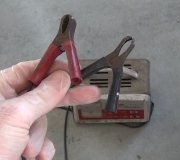( Before I performed this test, the battery was fully charged. )
Ok, when the neg. Battery terminal is removed and a test light held on the neg. Post and to the disconnected neg. Cable, the light will either go on and dim-off quickly, or the light will blink regularly.
The vehicle runs very smoothly and is making good power, etc.
The primary problem is that after replacing the battery and installing a rebuilt alternator, the battery still drains.
Subsequently the vehicle won't start until boosted.
I discovered that when I removed a 40 amp fuse from the pass. Engine bay fuse panel, the test light will not come on, dim-off, or flash as before.
If this is the circuit with the 'short' in it, the Haynes manual does not tell what the 40 amp fuse circuit is above ( windshield-wards) from the main 80 amp fuse.
When the ignition is on, the test light on the disconnected neg. Cable to neg. Post is steady and bright.
Possibly the test-light test is normal.
But, the volt meter read 14 volts when I first got the rebuilt alternator.
After driving for @ 1 hr. The car is shut off and will start again.
But the battery is slowly losing charge.
If the behaviour of that 40 amp fuse is normal, perhaps the exciter diodes are faulty in the alternator.
Anyways, any suggestions will help.
Hopefully the ECU is not the culprit, whatever that is.
The gist of my query is to get the alternator to keep the battery charged, or fix a possible 'short'.
Saturday, July 28th, 2007 AT 9:17 PM



